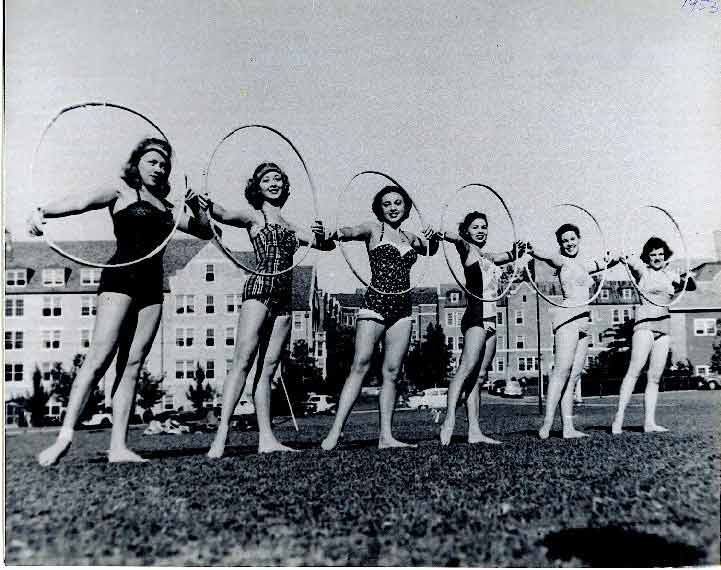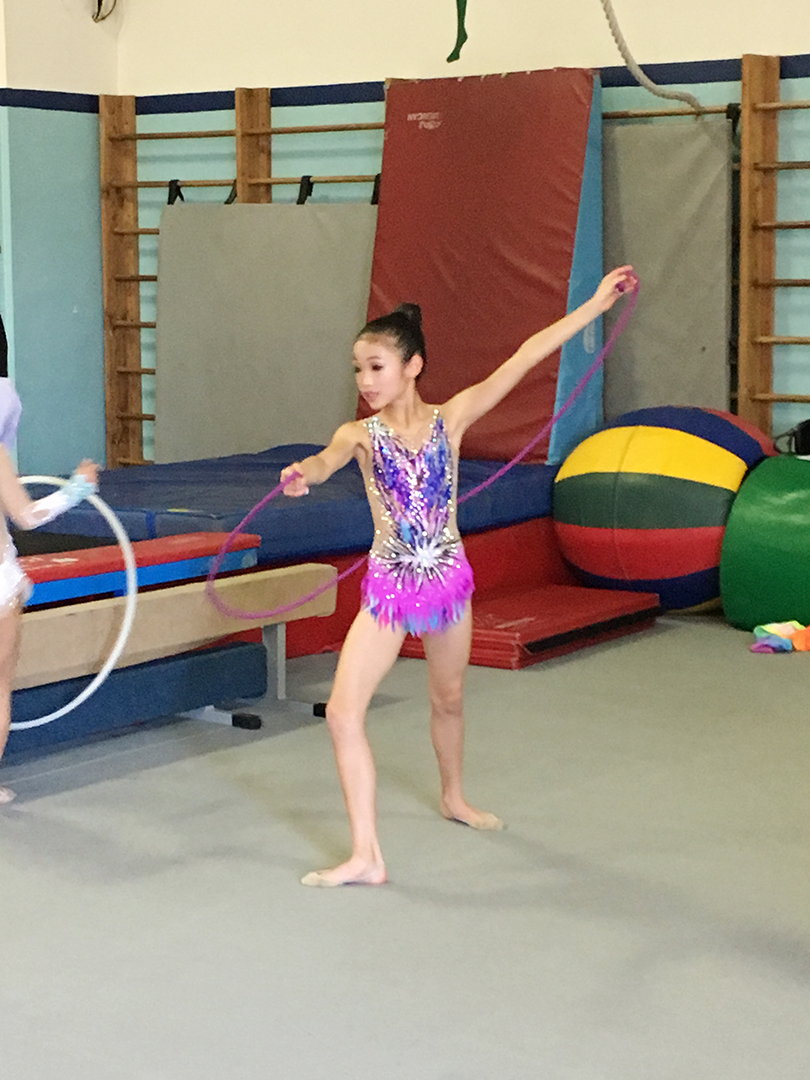Rhythmic gymnastics is a sport in which gymnasts perform on a floor with an apparatus: hoop, ball, clubs, ribbon or rope. The sport combines elements of artistic gymnastics, dance, and calisthenics; gymnasts must be strong, flexible, agile, dexterous and coordinated. Rhythmic gymnastics is governed by the International Gymnastics Federation (FIG). At the international level, rhythmic gymnastics is a women-only sport.
The most prestigious competitions, besides the Olympic Games, are the World Championships, World Games, European Championships, European Games, the World Cup Series, and the Grand Prix Series. Gymnasts are judged on their artistry, execution of skills, and difficulty of skills, for which they gain points. They perform leaps, balances, pivots, and flexibility movements, along with tossing, catching, rolling and otherwise manipulating the apparatus.

Rhythmic Gymnastics: A Brief History
In the 1800s rhythmic gymnastics operated under the guise of group gymnastics, and included a trace of elementary choreography. It grew slowly until the first experimental competitions appeared in eastern Europe in the 1930s when its newfound complexity began to draw a wider audience.
Rhythmic gymnastics evolved from a host of related disciplines. It incorporates elements from classical ballet, such as pli?s and arabesques, as well as the German system of emphasizing apparatus work for muscle development and the Swedish method of using free exercise to develop a rhythm.
The FIG recognized rhythmic gymnastics as an official discipline in 1963, and a year later organized an international tournament in Budapest. In 1964 the tournament was officially declared the first Rhythmic Gymnastics World Championships, and Ludmila Savinkova of the Soviet Union became the first world champion.The number of athletes grew as interest spread to other parts of the world. Gymnasts from the United States first appeared at the championships in 1973, and rhythmic gymnastics slowly emerged from the shadow of the long-established artistic discipline to enter the Olympic program in 1984.
Since its integration into the Games in 1984 in Los Angeles, rhythmic gymnastics has always been a part of the Olympic program. In its inaugural year, it was Canada?s Lori Fung who won the gold medal. Until 1992 in Barcelona, only one individual event was on the program. A second, team event was added to the program in 1996 in Atlanta.

Rhythmic Gymnastics: Gymnasts
Olympic rhythmic gymnastics is only for female participants. Gymnasts start at a young age and become age-eligible to compete in the Olympic Games and other major international competitions on January 1 of their 16th year (For example, a gymnast born on 12-31-2004 would be age-eligible for the 2020 Olympics). Gymnasts typically start training at a very young age and those at their peak are typically in their late teens (15?19) or early twenties, but since recently it is common to see gymnasts achieving their peak after reaching their twenties.
Top rhythmic gymnasts must have many qualities; balance, flexibility, coordination, and strength are some of the most important. They also must possess psychological attributes such as the ability to compete under intense pressure, in which one mistake can cost them the title, and the discipline and work ethic to practice the same skills over and over again.
Currently, a gymnast can perform in the individual event or in the group event. They perform routines in 12 x 12-meter areas, accompanied by music. Since 1995, groups consisted of 5 gymnasts, but originally six gymnasts composed a group, although around the 1980s this could be even eight. The duration of a group exercise should be two and a half minutes, one minute more than the individual one, which is one minute and a half.
Rhythmic Gymnastics: Apparatus
The FIG selects which apparatus will be used in competitions, only four out of the five possible apparatuses are sanctioned. Hoop and rope were the first apparatus used at World Championships, followed later by ball, ribbon, and clubs.

Rope
It may be made of hemp or synthetic material that retains the qualities of lightness and suppleness. Its length is in proportion to the size of the gymnast. When the middle of the rope is held down by the feet, both ends should reach the gymnasts? armpits. One or two knots at each end are for keeping hold of the rope while doing the routine.
The rope must be colored, either all or partially. It may be either of a uniform diameter or be progressively thicker in the center provided that this thickening is of the same material as the rope.The fundamental requirements of a rope routine include leaps and skipping. Other elements include swings, throws, circles, rotations, and figures of eight.

Hoop
A hoop may be made of plastic or wood, provided that it retains its shape during the routine. The hoop is chosen based on the gymnast?s size and should not extend beyond the hip bone when placed standing up on the floor. The interior diameter is from 51 to 90 cm and the hoop must weigh a minimum of 300g. Children and hope divisions, a minimum of 225 grams. The hoop may be of natural color or be partially or fully covered by one or several colors, and it may be covered with adhesive tape either of the same or different color as the hoop. Hoops are often customized using colored tapes to match the design of the leotards.The fundamental requirements of a hoop routine include rotation around the hand or body and rolling, as well as swings, circles, throws, and passes through and over the hoop.

Ball
It is made of either rubber or synthetic material (pliable plastic) provided it possesses the same elasticity as rubber. Senior and junior gymnasts are 18 to 20 cm in diameter and must have a minimum weight of 400g. The ball can be of any color.
The ball should rest in the gymnast?s hand and not rest against the wrist or be able to be grasped. Fundamental elements of a ball routine include throwing, bouncing or rolling.
The gymnast must use both hands and work on the whole floor area whilst showing continuous flowing movement. The ball is to emphasize the gymnasts flowing lines and body difficulty.

Clubs
It is made of either rubber or synthetic material (pliable plastic) provided it possesses the same elasticity as rubber. Senior and junior gymnasts are 18 to 20 cm in diameter and must have a minimum weight of 400g. The ball can be of any color. The ball should rest in the gymnast?s hand and not rest against the wrist or be able to be grasped. Fundamental elements of a ball routine include throwing, bouncing or rolling.
The gymnast must use both hands and work on the whole floor area whilst showing continuous flowing movement. The ball is to emphasize the gymnasts flowing lines and body difficulty.

Ribbon
It is made of satin or another similar material cloth of any color; it may be multi-colored and have designs on it. The ribbon itself must be at least 35 g (1.2 oz), 4?6 cm (1.6?2.4?) in width and have a minimum length of 6m (20?) for seniors and 5m (16.25?) for juniors. The ribbon must be in one piece.
The end that is attached to the stick is doubled for a maximum length of 1m (3?). The ribbon is fixed to the stick by means of a supple attachment such as thread, nylon cord, or a series of articulated rings. Compulsory elements for the ribbon include flicks, circles, snakes and spirals, and throws. It requires a high degree of co-ordination to form the spirals and circles as any knots which may accidentally form in the ribbon are penalized. During a ribbon routine, large, smooth and flowing movements are looked for. The ribbon may not stop moving or else points are taken off.

Scoring System
In rhythmic gymnastics competitions exercises are evaluated by the following parameters which are reviewed every four years, the system defining the FIG Code of Points. After each Olympic games, the scoring process is modified.
In the current Code of Points (2017-2020), the final score of a routine is the sum of the difficulty score and execution score. Penalties incurred will also be deducted from the final score. The difficulty score is open-ended with no maximum score, while the execution score has a starting value of 10 points. There are also penalties, which are realized by subtracting points from the final note for certain specified mistakes made by the gymnast.
There are many benefits to your children participating in gymnastics, even if they don?t compete professionally. It?s a healthy form of exercise that instills discipline, hard work, and dedication. Your child can learn all about expression through artistic movement while creating lasting relationships with their coaches and peers.
Fun Facts About Rhythmic Gymnastics
There are some interesting things about this competitive sport that you may not know! For example, even though rhythmic gymnastics is a female-only Olympic Sport, there are other competitions that include male participants. Japan and several countries in Europe already have their own national category for men?s rhythmic gymnastics.

Gymnasts must not only do the splits but also push it past the 180-degree status quo. In order to accomplish those leaps and acrobatic moves, athletes must be able to do oversplits. These moves require them to bend their legs completely in front and behind them!
Canadian athlete Lori Fung won the first individual Olympic gold medal. And Spain won the first group gold medal. Overall, however, Russia has dominated the sport in both the individual and group Olympic competitions.
Athletes typically begin their training at an early age work for years before they can have the chance to compete professionally. They must become masters of their artistry and perform under extreme pressure. Trainers painstakingly create each routine in minute detail and then practice for hours every day. However, gymnasts will tell you that while it?s a hard path to take, they find great satisfaction in their sport.
There are many benefits to your children participating in gymnastics, even if they don?t compete professionally. It?s a healthy form of exercise that instils discipline, hard work, and dedication. Your child can learn all about expression through artistic movement while creating lasting relationships with their trainers and peers.
If you?re interested in enrolling your child in this artistic sport, reach out to the Los Angeles School of Gymnastics or visit our website to get started!


0 comments